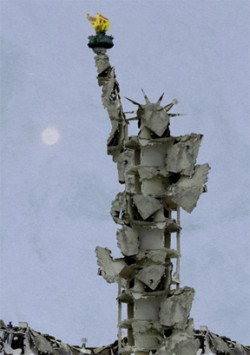Tamam Azzam: Artist from Art to Revolution
Courtesy of Al Mudon electronic newspaper
Dima Wannous, a Syrian journalist and daughter of the late noted playwright Saddallah Wannous, has been providing exceptional coverage of the Arab art and cultural scene for the newly established Lebanese electronic newspaper, Al Mudon. She recently talked with Syrian artist Tamam Azzam, whom she claims remains as engaged in documenting the events of the Syrian revolution through his paintings as he was almost two years ago. As Wannous wrote, “From the map to the sniper’s bullet, to the destruction of the liberty statue in one of Homs’s suburbs that was transformed into piles of rubble. From the students who returned to their classrooms to find nothing but destruction, to the MiG aircraft which flies across the ‘national’ air space to bomb the ‘enemies.’ Didn’t he get bored from this documentation?”
Like many critics, Wannous is concerned with ‘political art’: what is the future of such art when the revolution succeeds or if it were to be defeated? “Despite his continued passion in documenting the most important events of the revolution (bombing bakeries, use of chemical weapons, dire conditions in the refugee camps…), the viewer perhaps still asks: to what extent would these works continue? Does their importance stem from the moment or will they continue for many years as a witness of the revolution,” wrote Wannous.” Azzam offers a realistic, and even objective answer: “Undoubtedly the influence of these works will vary with time. I often try to complete the works under a dual influence, that is, of the moment on the one hand, and of artistic value on the other. I am taken by the moment and do not give much attention to the future, for there is no past before the revolution for me.”
Azzam’s assessment of what art can do is evident when telling Wannous, “as time goes, I think that this is all I can do, and I do not believe that painting or writing or any other form of expression can express fully the sorrow of an old man waiting in front of a bakery, the bitter cold in the refugee camps, and the hunger of the refugees. We could not comprehend the full impact of the moment a missile hit or the sound of aircraft. Thus we borrow a little from people’s fears and sorrows, just enough so that we can express our own sorrow.”
But Azzam comes across as an artist moving away from “art to revolution” and even “crossing the line,” when he suggests to Wannous that he would send “to the Zaatari refugee camp (in Jordan) three huge volumes of books by Adonis, some plays by Ziad al-Rahbani, films by Dareed Laham, and poetry collections by Unsi al-Haj and Nazih al-Afash, hoping they will make a fire to warm a Syrian child.” Azzam’s anger with some Lebanese and Syrian intellectuals who did not stand with the revolution is overt, as they provided intellectual ‘legitimacy’ to a murderous regime.
–Elie Chalala
© Copyright 2013 AL JADID MAGAZINE


 Poasis II: Selected Poems 2000-2024
Poasis II: Selected Poems 2000-2024 “Todesguge/Deathfugue”
“Todesguge/Deathfugue” “Interglacial Narrows (Poems 1915-2021)”
“Interglacial Narrows (Poems 1915-2021)” “Always the Many, Never the One: Conversations In-between, with Florent Toniello”
“Always the Many, Never the One: Conversations In-between, with Florent Toniello” “Conversations in the Pyrenees”
“Conversations in the Pyrenees” “A Voice Full of Cities: The Collected Essays of Robert Kelly.” Edited by Pierre Joris & Peter Cockelbergh
“A Voice Full of Cities: The Collected Essays of Robert Kelly.” Edited by Pierre Joris & Peter Cockelbergh “An American Suite” (Poems) —Inpatient Press
“An American Suite” (Poems) —Inpatient Press “Arabia (not so) Deserta” : Essays on Maghrebi & Mashreqi Writing & Culture
“Arabia (not so) Deserta” : Essays on Maghrebi & Mashreqi Writing & Culture “Barzakh” (Poems 2000-2012)
“Barzakh” (Poems 2000-2012) “Fox-trails, -tales & -trots”
“Fox-trails, -tales & -trots” “The Agony of I.B.” — A play. Editions PHI & TNL 2016
“The Agony of I.B.” — A play. Editions PHI & TNL 2016 “The Book of U / Le livre des cormorans”
“The Book of U / Le livre des cormorans” “Memory Rose Into Threshold Speech: The Collected Earlier Poetry of Paul Celan”
“Memory Rose Into Threshold Speech: The Collected Earlier Poetry of Paul Celan” “Paul Celan, Microliths They Are, Little Stones”
“Paul Celan, Microliths They Are, Little Stones” “Paul Celan: Breathturn into Timestead-The Collected Later Poetry.” Translated & with commentary by Pierre Joris. Farrar, Straus & Giroux
“Paul Celan: Breathturn into Timestead-The Collected Later Poetry.” Translated & with commentary by Pierre Joris. Farrar, Straus & Giroux
Its ‘The Man For All Seasons’ question. Is silence a statement, yea or nay, or is it just silence? Art is art, as likely to represent the times as to attempt to shape it. As always, it is in the eyes of the ‘beholder.’